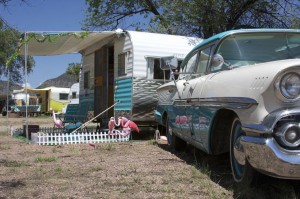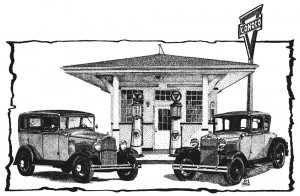By George Sibley
I got raked over the coals by a reader in last month’s Colorado Central (August 2011, p. 20), on my June column complaining about “private-sector capitalism.” It was a thoughtful enough critique to warrant some response this month. (Actually, my first thought was – great! It’s not a black hole; someone is actually reading and thinking about this stuff!)
I’ll start by saying that the main thing I wanted to convey in that column was my confusion and frustration about American economics – a confusion involving corporate cash, job creation, local business destruction, tax policy, tax evasion, investment return, retirement plans, and all the other tangled elements of what passes these days for an economy that we call “free market capitalism.” The reader’s basic challenge: if I don’t like “private-sector capitalism” as practiced by Amazon, the company I was ragging on – what do I suggest instead?
I honestly don’t have an answer; I think my real challenge is just to better focus my confusion. And that may require starting with a more basic description of what an economy is, or is supposed to be, and not with those value-laden, ideological political economies – capitalism, socialism, Marxism, marketism, whatever. The college-text definition of an economy I remember is: a society’s system for the production and distribution of the goods and services that enables members of the society to survive, hopefully thrive.
My college text – still descriptive, no ideology yet – posited three basic variations for such systems: 1) traditional economies, in which sons and daughters carry forward the productive or distributive functions of their parents; 2) command economies, in which production and distribution of goods and services are controlled and directed by centralized authorities; and 3) market economies, in which the production and distribution of goods and services are left to the members of the economic society to work out, with each individual, desiring to succeed or at least survive, coming up with some way of positively contributing to the necessary production and distribution.
All three of these basic economies are “capitalist” in the sense that they all require the cultivation and investment of some kind of capital – usually a complex mix of financial capital, idea capital, human capital (if only one’s labor), and resource capital. It’s problematic, I think, that “advanced societies” tend to obsess most over the financial capital. The Dow.
Anyway – I look around me, over here in the Upper Gunnison, and ask myself, what kind of an economy do I live in? We Americans think of ourselves as a market economy, and I can look around the valley and see that. When I want coffee, or food, or clothes, or a day of skiing, there are businesses run by individuals or corporations who knew I would want those things and are prepared to provide them for me – a distributive function for the most part in this valley, not much local production (except for the skiing and the beer at the Gunnison Brewery). The market economy here gets all the things I need or want trucked in from somewhere else. Heilbroner calls a market economy “a vast exchange between buyers and sellers,” and it certainly is vast when practically everything we Gunnisonites need or want comes from Asia in big ships or planes.
But when I look a little harder at our economic life in the valley here – I see those other kinds of economic activity too. Most of the valley floor is cattle ranches that are largely a father-to-son traditional economy – meaning: if the kids don’t want to stay in the valley and take over dad’s operation (which his dad took over from his dad), the ranch will probably pass into the (real estate) market economy and – unless our economy is really tanked – be subdivided for oversize vacation houses. The ranchers do of course trade goods for goods and services in the market economy, but usually at a disadvantage (buying at seller prices and selling at buyer prices), and mountain ranching would probably disappear were it not a “traditional culture” as much as an economy.
But a command economy – surely not here? Well – we don’t have a total command economy, but we do have to give portions of our earnings to at least three levels of governments, which redistribute “our money” for roads, bridges, water and sewer systems, law officers, a safety net for those with bad luck or bad judgment, and – at more remote levels – for foreign wars that are supposedly “defending” me from something, or bailouts for banks that thank us by socking us thirty bucks for simple arithmetic errors … et cetera. The ambiguous fact that we elect what is supposed to be the leadership of these governments does not alter their “command” aspect. If I refuse to pay part of the sums our governments levy on me, because they fail to do some of the things they promised to do, they will come take the money or my property – something I know from experience. That part of our economy feels like a command economy to me – but I will hasten to add that I generally approve of 90 percent of what the local government does with my money, 70 percent at the state level, and about 30 percent at the national level.
I believe that this kind of “mixed economy” we live in fundamentally makes sense in the economic processes of producing and distributing the goods and services we need (or just want). A functioning market economy offers a lot of personal freedom and opportunities in the application of imagination and resources to fulfilling demands, rewarding success with wealth and failure with the opportunity to try, try again. Residual traditional economies usually protect cultural values that don’t compute in the market economy’s math. And the command portion of the mixed economy takes care of things we know, as adults, we need to be taking care of, but as aging adolescents we might not want to support at a necessary level. That at least is what those sectors of a mixed economy do when they are functioning as they should.
The big challenge with a mixed economy, however, is how to keep the three sectors in a functional balance – and behind that, is the more formidable challenge of agreeing on what the balance should be.
Today, for example, many Americans are persuaded that the command sector, our national and state governments, have gotten out of balance, so they are working vigorously to reduce that whole sector to something “we can drown in the bathtub,” in the memorable hyperbole of Grover Norquist.
On the other hand, I am more inclined to argue that it is the market sector that has gotten out of balance, and is running amuck in ways that are counter to its basic promise of nurturing creative and expansive ventures that will improve our lives. Our once-free market economy seems to me to have become dominated by huge corporations that do everything in their considerable power to eliminate the competition that market economies supposedly thrive on, that either quash or co-opt any creative impulse that threatens a profitable status quo, that are reviving the 19th-century idea that “labor” is nothing now but a cost to be cut – and finally, that have purchased and “incorporated” most of the command sectors of the economy as wholly owned subsidiaries with paid-for legislatures, governors and a president in place to rubberstamp virtually anything they want.
So you tell me now: how do we get the market and command sectors of our economy back in a reasonable working balance – especially when we can’t seem to even agree on who or what is out of balance?
A fair amount of that disagreement is ideological – almost religious. The free marketeers believe – in the face of all contrary evidence – that all we have to do is cut taxes, remove regulations and stop coddling the people, and the private sector will leap up with a lusty roar and rebuild a healthy 19th-century economy. Never mind that the overall economy has only gotten worse after a long decade of tax cutting and deregulating; and now, with the need obvious for economic initiative and job creation, the corporate owners and operators of the market economy are sitting on their hands (and mountains of cash) waiting for somebody else to start, while their capital market gets the fainting fantods every time government bonds twitch. Where are all those brave and brawny Ayn Rand heroes?
The “Keynesian Kapitalists,” on the other hand, are arguing that only the government can jump-start the economy, with new investment in job-creating infrastructure – never mind that the government is mired in debt due to endless wars, a bloated military, an out-of-control health care system, tax inequity, and a legislature elected on the promise to drown itself in the bathtub.
So what do we do? I don’t know – especially since a civil discourse among the big players seems impossible. But I hope I’ve at least better articulated my confusion and concern. Meanwhile, these valleys with their debt-haunted traditional ranch economies continue to be exceptionally lush and beautiful this year, and up in those command-economy, fiscally-distressed National Forests the wildflowers just go on and on. Hope you’re managing to get out in it.
George Sibley was born in Western Pennsylvania, but was conceived in Colorado by Colorado natives, and thus considers himself to be a native Coloradan.




